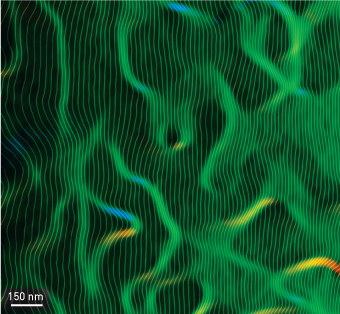Sep. 12, 2014 Research Highlight Chemistry Physics / Astronomy
Magnetism intensified by defects
Electron microscopy reveals how certain nanoscale crystal defects can dramatically intensify ferromagnetism in metal alloys
 Figure 1: An electron holography image of an iron–aluminum alloy containing two-dimensional zones of atomic disorder. Contrary to expectations, enhanced ferromagnetic spin order inside the disordered regions produces large magnetic flux densities. © 2014 Yasukazu Murakami, RIKEN Center for Emergent Matter Science
Figure 1: An electron holography image of an iron–aluminum alloy containing two-dimensional zones of atomic disorder. Contrary to expectations, enhanced ferromagnetic spin order inside the disordered regions produces large magnetic flux densities. © 2014 Yasukazu Murakami, RIKEN Center for Emergent Matter Science
Magnetic materials are fundamental to many technologies, from data storage to next-generation spintronic devices. However, as integrated circuits become increasingly miniaturized and the sizes of magnetic components approach nanoscale dimensions, magnetic properties can disappear. Yasukazu Murakami and colleagues from the RIKEN Center for Emergent Matter Science and Tohoku University in Japan have now obtained important insight into the development of stable, strong nanomagnets, thanks to the discovery of amplified magnetization due to nanoscale atomic disorder in iron–aluminum alloys1.
Iron-rich iron–aluminum alloys are unusual because small mechanical or thermal deformations can abruptly boost the materials’ ferromagnetic properties. Researchers believe that this effect arises due to the transition between a chemically ordered phase and a chemically disordered phase that increases the density of the nearest iron–iron atomic pairs within the crystal. The ordered phase contains a type of planar defect referred to as antiphase boundaries (APBs), with lowered degree of order.
Observing APBs is challenging, however, because most experimental tools are unable to isolate magnetic signals arising from complex, narrow nanoscale interfaces. Murakami and his colleagues solved this problem using their recently developed split-illumination electron holography technique. This electron microscopy technique divides the incident electron wave into two beams—one that interacts with the sample, and another that provides a reference vacuum signal. Interference of the two beams produces electron holograms with sufficiently high signal-to-noise levels to detect miniscule changes in interfacial magnetic fields.
The researchers used their electron holography technique to examine a heat-treated alloy consisting of 70% iron and 30% aluminum and observed APBs as thin, wavy patterns no more than three nanometers wide. Closer inspection revealed that magnetic flux densities in the APBs were amplified by 60% compared with the matrix region in the ordered phase due to an increase in the density of nearest iron–iron pairs. Furthermore, holographic images captured during heating of the alloy revealed that even at elevated temperatures, the remarkable interfacial spin ordering was confined to APB regions (Fig. 1).
Murakami notes that these unexpected findings, which appear to contradict traditional concepts of magnetic spin ordering, could lay the groundwork for the engineering of nanomagnets with APB-induced activity, guided by high-resolution electron microscopy. “The advanced electron holography techniques used in this work achieved pinpoint magnetization analysis of the nanometer-sized interface region,” he says. “The methods can be widely applied to leading problems in spintronics, physics, chemistry and materials science.”
References
- 1. Murakami, Y., Niitsu, K., Tanigaki, T., Kainuma, R., Park, H. S. & Shindo, D. Magnetization amplified by structural disorder within nanometre-scale interface region. Nature Communications 5, 4133 (2014). doi: 10.1038/ncomms5133
